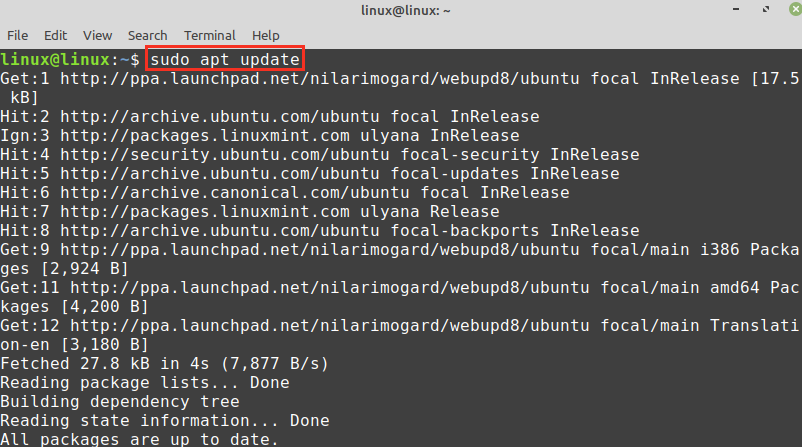The PulseAudio is an open-source volume control and audio effects tool. It allows us to control and tune the audio settings. The PulseAudio Equalizer has a multi-band interface. Therefore, you can easily adjust the slider when the audio is playing.
As PulseAudio is a popular open-source tool, it is included in Linux Mint 20 standard repositories installed from there. Moreover, it can also be installed on Linux Mint 20 from the external PPA repository.
This post explains the installation of PulseAudio-Equalizer on Linux Mint.
Installing PulseAudio on Linux Mint 20 from the standard repositories
Open the terminal window, and first, update the apt listing with the command:
Type the below-given command to install PulseAudio on Linux Mint 20 from the standard repositories:
Press ‘y’ to continue installing PulseAudio.
Once the PulseAudio is installed, verify the installation with the command:
The Pulseaudio 13.99.1 is successfully installed on my Linux Mint 20.
The PulseAudio offers many extra modules included in Linux Mint 20 standard repositories and can be installed easily with apt command.
Installing PulseAudio-Equalizer on Linux Mint 20 from the PPA repository
The PPA repositories are created and maintained by the developers. Fire up the terminal and perform the following steps to install PulseAudio from the PPA repository:
Step 1: Add PulseAudio PPA repository
First, add the PulseAudio PPA repository using the command:
The PulseAudio PPA repository will be added successfully.
Step 2: Update apt-cache
Once the PPA repository is added successfully, update the apt cache with the command:
Step 3: Install PulseAudio
Next, install the PulseAudio with the command:
Press ‘y’ to continue installing PulseAudio.
Getting started and configuring the PulseAudio-Equalizer
Once you have installed PulseAudio using any recommended method, open the PulseAudio tool with the command:
While opening the PulseAudio tool, you may encounter the error stating that some modules are missing. In this case, open the PulseAudio’s configuration file with the command:
Add the below-given lines at the bottom of the/etc/pulse/default.pa file.
load-module module-dbus-protocol
Save the file and exit the nano editor by pressing ctrl+x.
Next, kill the PulseAudio service and restart it:
Now, open the PulseAudio with the command:
The PulseAudio-Equalizer is ready for use.
How to remove PulseAudio-Equalizer
At any point, if you wish to remove PulseAudio from Linux Mint 20, then type the below-given command to do so:
Press ‘y’ to continue removing PulseAudio Equalizer.
The PulseAudio Equalizer will be removed successfully.
Conclusion
PulseAudio Equalizer is a free and open-source tool for volume control. It is part of Linux Mint 20 standard repositories and can be installed with apt command. Moreover, it is also available from an external PPA repository. This article shows the PulseAudio Equalizer installation on Linux Mint 20 system from the standard and PPA repositories.

















